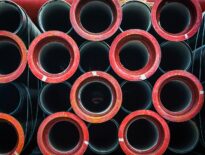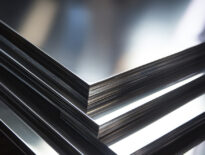What is a Pipe Schedule?
A pipe schedule refers to the wall thickness of a steel pipe. This schedule is indicated by a number that represents a standardized wall thickness, not the actual thickness itself. These standardized wall thicknesses were set by the American National Standards Institute (ANSI) and are based on a formula considering the pipe’s nominal size and its pressure rating.
For example, a pipe with a schedule 40 has a wall thickness of about 1/8 inch, while a schedule 80 pipe has a thickness of around 1/4 inch. As the schedule number increases, so does the wall thickness, making the pipe suitable for higher pressure applications.
It’s important to note that different types of pipes, like seamless or welded pipes, and different materials, such as carbon steel, stainless steel, or alloy steel, may have varying schedules for the same pipe size. Choosing the correct pipe schedule for your application is crucial to ensure the pipe can handle the pressure and stress it will encounter.
What is the difference between Schedule 40 vs Schedule 80?
The main difference between Schedule 40 and Schedule 80 steel pipes is the wall thickness. Schedule 40 pipes have thinner walls, making them suitable for low-pressure applications such as residential plumbing and irrigation systems, where the pressure does not exceed 1,000 PSI.
In contrast, Schedule 80 pipes have thicker walls, making them ideal for high-pressure applications like industrial processes, hydraulic systems, and underground piping. They are built to handle higher pressures and greater stress than Schedule 40 pipes.
For example, Schedule 40 pipes typically have a wall thickness of around 0.109 inches, while Schedule 80 pipes have a wall thickness of about 0.154 inches. This makes Schedule 80 pipes roughly 30% thicker than Schedule 40 pipes.
Although Schedule 80 pipes are stronger and more durable, they are also more expensive due to the additional material and manufacturing time required for their thicker walls. When choosing a pipe, it’s important to balance the pressure requirements of your application with the cost of the pipe, considering whether the extra strength of Schedule 80 is necessary.
Schedule 80 vs Schedule 40 PVC
The following table highlights the key differences between Schedule 40 and Schedule 80 PVC pipes:
| Feature | Schedule 40 PVC Pipe | Schedule 80 PVC Pipe |
| Wall Thickness | Thinner | Thicker |
| Pressure Rating | Lower | Higher |
| Durability | Less durable | More durable |
| Cost | Less expensive | More expensive |
| Common Applications | Residential plumbing, irrigation systems, drain-waste-vent systems, low-pressure applications | Industrial processes, hydraulic systems, underground piping, high-pressure applications |
Schedule 40 PVC pipes have thinner walls and are less durable compared to Schedule 80 PVC pipes. They are typically used in low-pressure applications like residential plumbing, irrigation, and drain-waste-vent systems.
On the other hand, Schedule 80 PVC pipes have thicker walls and are more durable, making them suitable for high-pressure applications such as industrial processes, hydraulic systems, and underground piping.
Due to their thicker walls and higher pressure rating, Schedule 80 PVC pipes are more expensive than Schedule 40 PVC pipes. When choosing a PVC pipe for a specific use, it’s crucial to weigh the pressure requirements against the cost to determine if the extra durability of Schedule 80 is necessary.
How Is Pipe Scheduling Used
Pipe scheduling ensures that steel pipes have walls thick enough to withstand the pressures and stresses of their intended use. The schedule number indicates the wall thickness: higher numbers mean thicker walls.
This system is crucial in the steel industry to ensure the safety and reliability of pipes. Different schedules are used for various pipes and materials, and selecting the correct schedule is vital for the pipe to handle its specific pressures and stresses.
For example, Schedule 40 pipes are commonly used in low-pressure settings like residential plumbing and irrigation systems because they have thinner walls and are cost-effective. In contrast, Schedule 80 pipes, with thicker walls, are used in high-pressure applications such as industrial processes and hydraulic systems because they can endure greater stress.
Overall, pipe scheduling is key to ensuring the safety and durability of steel pipes across diverse applications. Choosing the right pipe schedule for a given application helps prevent failures and extends the pipe’s lifespan.
Schedule 40 vs Schedule 80 Pipe – Major Differences
Pressure
Pipe scheduling is essential to determine how much pressure a plumbing system can handle. Higher schedule numbers indicate thicker pipe walls, which can withstand greater fluid pressures. For high-pressure applications, such as industrial or hydraulic systems, Schedule 80 pipes are recommended due to their thicker walls. Schedule 40 pipes, with thinner walls, are typically used in low-pressure applications like residential plumbing and irrigation systems. Selecting the right schedule ensures the pipe can handle the working pressure requirements.
NPS and Outer, Inner Diameter
Nominal Pipe Size (NPS) measurements are the same for both Schedule 40 and Schedule 80 pipes. The key difference lies in the inner diameter (ID). Schedule 80 pipes have thicker walls, reducing their inner diameter compared to Schedule 40 pipes. This thicker wall makes Schedule 80 pipes more suitable for high-pressure applications but can slightly reduce fluid flow. Schedule 40 pipes, with a larger inner diameter, are better for applications where flow rate is a priority.
Cost
Schedule 40 pipes are generally more affordable than Schedule 80 pipes due to their thinner walls requiring less material. Schedule 80 pipes, with thicker walls, are more expensive but provide increased strength and durability for high-pressure applications. When choosing between the two, it’s important to balance cost with the application’s pressure and durability requirements.
Color
Typically, Schedule 40 pipes are white, while Schedule 80 pipes are gray. This color distinction can help quickly identify the pipe schedule. However, not all manufacturers follow this color code, so always check the information printed on the pipes and fittings to confirm the schedule.
Installation
The installation process for Schedule 40 and Schedule 80 pipes made from the same material is similar. The ASTM standard ensures that the outside diameters for all pipes with the same NPS are identical, allowing different schedules of pipes to be joined using standard fittings and methods. Proper installation procedures, such as cleaning, aligning, and supporting the pipes correctly, are essential to ensure the system functions safely and efficiently.
Application
Schedule 80 pipes, with their thicker walls, are stronger and more durable, making them suitable for high-pressure, high-stress, and chemically reactive applications. Schedule 40 pipes are more suitable for low-pressure applications where cost is a significant factor. When choosing the right pipe schedule, consider the fluid pressure, mechanical strain, and chemical interaction the pipes will face. Consulting a qualified plumbing professional can help determine the best solution for specific needs.
In summary, Schedule 40 pipes are ideal for low-pressure applications and are more cost-effective, while Schedule 80 pipes are better suited for high-pressure and high-stress applications due to their thicker walls and increased durability.
Formula for Pipe Schedule
The pipe schedule is determined by the following formula:
Sch.=P[σ]t×1000\text{Sch.} = \frac{P}{[σ]t} \times 1000Sch.=[σ]tP×1000
where:
- PPP is the planned pressure, measured in megapascals (MPa).
- [σ]t[σ]t[σ]t is the allowable stress of the material at the design temperature, also measured in megapascals (MPa).
Understanding the Variables
- Planned Pressure (P):
- This is the maximum pressure that the pipe is expected to handle during operation. It is critical to know this value to ensure the pipe’s walls are thick enough to withstand the pressure without failing.
- Allowable Stress ([σ]t):
- This is the maximum stress that the material can safely withstand at the operating temperature. Different materials and temperatures will have different allowable stress values, which are often provided by standards and material specifications.
Example Calculation
Let’s assume:
- Planned pressure (PPP) is 2 MPa.
- Allowable stress ([σ]t[σ]t[σ]t) of the material at the design temperature is 100 MPa.
Using the formula:
Sch.=2100×1000=20\text{Sch.} = \frac{2}{100} \times 1000 = 20Sch.=1002×1000=20
This means that the pipe schedule calculated for these conditions is 20.
Steel Pipe Schedule Chart (ANSI B36.10 & B36.19)
Understanding Pipe Schedule (SCH)
Pipe schedule (SCH) refers to the wall thickness of the pipe. It is a numerical representation indicating the pipe’s wall thickness and is crucial for selecting the right pipe for a specific application. Pipes with the same diameter can have different wall thicknesses, depending on their schedule.
Example Chart (Unit in Inches)
| Nominal Pipe Size (NPS) | Outside Diameter (OD) | SCH 5 | SCH 10 | SCH 20 | SCH 30 | SCH 40 | SCH 60 | SCH 80 | SCH 100 | SCH 120 | SCH 140 | SCH 160 |
| 1/8 | 0.405 | 0.035 | 0.049 | – | – | 0.068 | – | 0.095 | – | – | – | – |
| 1/4 | 0.54 | 0.049 | 0.065 | – | – | 0.088 | – | 0.119 | – | – | – | – |
| 1/2 | 0.84 | 0.065 | 0.083 | – | – | 0.109 | – | 0.147 | – | – | – | 0.188 |
| 3/4 | 1.05 | 0.065 | 0.083 | – | – | 0.113 | – | 0.154 | – | – | – | 0.219 |
| 1 | 1.315 | 0.065 | 0.109 | – | – | 0.133 | – | 0.179 | – | – | – | 0.25 |
| 1 1/2 | 1.9 | 0.065 | 0.109 | – | – | 0.145 | – | 0.2 | – | – | – | 0.281 |
| 2 | 2.375 | 0.065 | 0.109 | 0.218 | – | 0.154 | – | 0.218 | – | – | – | 0.344 |
| 4 | 4.5 | 0.083 | 0.109 | 0.218 | – | 0.237 | – | 0.337 | – | – | – | 0.531 |
| 6 | 6.625 | 0.109 | 0.134 | 0.28 | – | 0.28 | – | 0.432 | – | – | – | 0.718 |
| 8 | 8.625 | 0.109 | 0.148 | 0.322 | – | 0.322 | – | 0.5 | – | – | – | 0.906 |
Summary
Pipe scheduling categorizes steel pipes based on their wall thickness, denoted by schedule numbers. A higher schedule number indicates thicker walls, enhancing the pipe’s strength to withstand higher fluid pressures. Schedule 80 pipes are notably stronger and more durable compared to Schedule 40 pipes due to their thicker walls, making them suitable for applications requiring high pressure or temperature resistance. Schedule 40 pipes, with their thinner walls, are more cost-effective and commonly used in standard building applications where high pressure handling is not necessary. Choosing between Schedule 40 and Schedule 80 pipes depends on the specific demands of the application, with Schedule 80 preferred for environments requiring robust performance under challenging conditions.
FAQs-
What is stronger Schedule 40 or 80 steel pipe?
Schedule 80 steel pipes are stronger and more durable compared to Schedule 40 pipes. They are designed to withstand higher pressure and are commonly used in applications requiring heavy-duty performance. Schedule 40 pipes, while suitable for general-purpose applications, may not be as effective under extreme pressure or stress conditions as Schedule 80 pipes.
What is Schedule 40 steel pipe used for?
Schedule 40 steel pipes, whether galvanized or black, are versatile and commonly used in various applications beyond gas and water lines. They are popular for DIY projects and crafts due to their durability and availability.
What is Schedule 80 pipe used for?
Schedule 80 pipe, known for its thicker walls compared to Schedule 40, is primarily used in applications requiring higher pressure handling and durability. It is commonly utilized in wastewater management, chemical processing, and manufacturing plants where robustness and resistance to pressure are essential.


